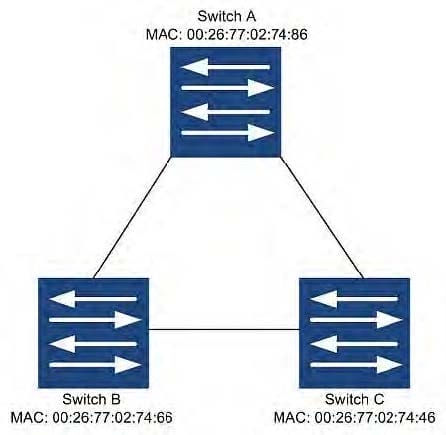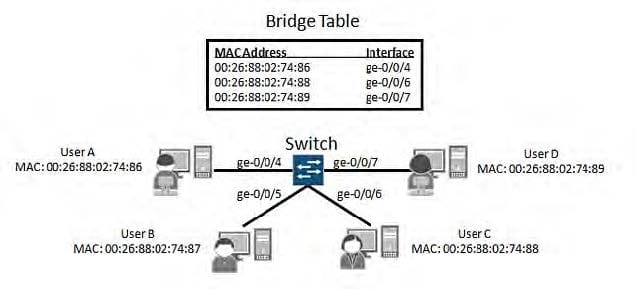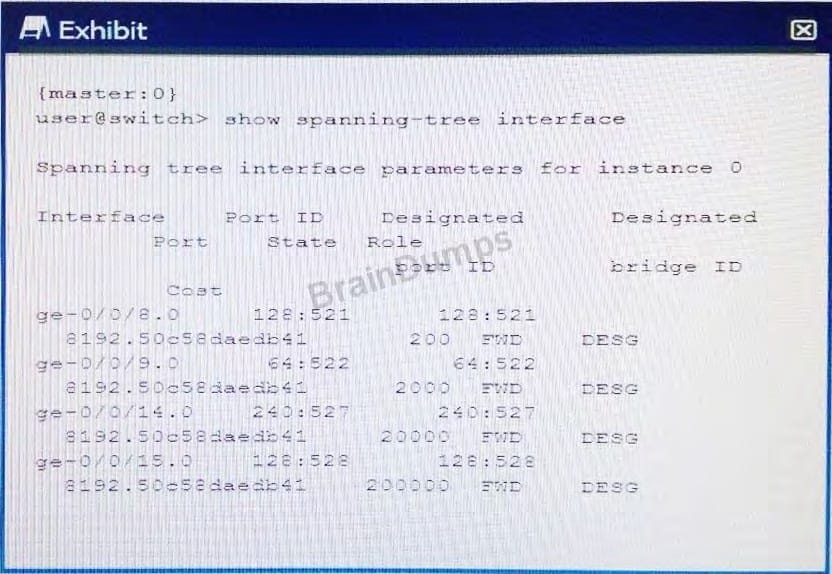Exam Details
Exam Code
:JN0-343Exam Name
:Juniper Networks Certified Internet Specialist (JNCIS-ENT)Certification
:Juniper CertificationsVendor
:JuniperTotal Questions
:563 Q&AsLast Updated
:Jun 04, 2025
Juniper Juniper Certifications JN0-343 Questions & Answers
-
Question 101:
-- Exhibit ?

-- Exhibit -In the exhibit, the switches have all been powered on at the same time and have the factory default RSTP configuration.
Which action would ensure that Switch A becomes the root bridge?
A. On Switch A, issue the set protocols rstp bridge-priority 28k command.
B. On Switch A, issue the set protocols rstp bridge-priority 36k command.
C. On Switch C, issue the set protocols rstp bridge-priority 36k command.
D. On Switch B, issue the set protocols rstp bridge-priority 28k command.
-
Question 102:
What are two benefits of the Bidirectional Forwarding Detection (BFD) protocol? (Choose two.)
A. Reduces the processing overhead for protocols that support BFD.
B. Reduces initialization overhead for protocols that support BFD.
C. Provides a common method for managing timers for the supported protocols.
D. Provides protocols with an efficient detection method when establishing forwarding paths.
-
Question 103:
-- Exhibit -[edit]
user@R1# show interfaces ge-0/0/1
unit 0 {
family inet {
address 10.10.10.1/24 {
vrrp-group 10 {
virtual-address 10.10.10.254;
priority 254;
}
}
}
}
[edit]
user@R2# show interfaces ge-0/0/1
unit 0 {
family inet {
address 10.10.10.2/24 {
vrrp-group 10 {
virtual-address 10.10.10.254;
priority 1;
}
}
}
}
-- Exhibit -Using the configuration details shown in the exhibit, which two statements are true? (Choose two.)
A. R1 will become the master VRRP router.
B. R2 will become the master VRRP router.
C. If the elected master VRRP router fails, and then returns to an operational state, it will return to the master VRRP router role.
D. If the elected master VRRP router fails, and then returns to an operational state, it will assume the backup VRRP router role.
-
Question 104:
Which three statements are true when determining the master VRRP router? (Choose three.)
A. The lower priority is preferred.
B. The highest primary address is preferred if the priority is the same.
C. The router with preempt configured is the master.
D. The higher priority is preferred.
E. The router with the same primary and virtual address is the master.
-
Question 105:
-- Exhibit ?

-- Exhibit -User D is trying to send traffic to User B.
Referring to the exhibit, what will happen to the traffic?
A. The traffic will only be sent to User B.
B. The traffic will be flooded to all users except User D.
C. The traffic will be dropped by the switch.
D. The traffic will only be sent to User B and User C.
-
Question 106:
You have configured a GRE tunnel between two remote sites. This tunnel will be used to pass traffic using RFC 1918 addressing over the Internet. You have verified that the tunnel interface is up on both endpoints and see the output shown below: user@router> show interfaces gr-0/0/0.0 terse Interface Admin Link Proto Local Remote gr-0/0/0.0 up up Traffic between the remote sites is not being passed over this tunnel. Which action would resolve this problem?
A. You must use an IP-IP tunnel to support traffic using RFC 1918 addressing.
B. You must use NAT to translate the private addresses to a public address.
C. You must enable path MTU to ensure packets are properly fragmented.
D. You must enable the inet protocol family on the GRE interfaces.
-
Question 107:
What are two types of STP BPDUs? (Choose two.)
A. link-state
B. configuration
C. topology change notification
D. update
-
Question 108:
Based on the output shown in the exhibit, which statement is correct?

A. The ge-0/0/9 interface is using the default priority value.
B. This switch has a bridge priority of 32k.
C. This switch has been elected as the root bridge.
D. The ge-0/0/15 interface is using the default port cost.
-
Question 109:
Referring to the exhibit, what is the problem?
user@switch> show interfaces ae0
error: device ae0 not found
user@switch> show configuration
...
chassis {
nssu;
}
interfaces {
ge-0/0/3 {
ether-options {
802.3ad ae0;
}
}
ge-1/0/4 {
ether-options {
802.3ad ae0;
}
}
ae0 {
unit 0 {
family ethernet-switching {
vlan {
members default;
}
}
}
}
}
vlans {
default {
vlan-id 1;
}
}
A. Aggregated interfaces must be defined under the chassis stanza.
B. LACP is required for LAG to work.
C. The LAG member interfaces are configured across different line cards.
D. LAG requires more than two member links.
-
Question 110:
-- Exhibit ?
{master:0}
user@switch> show vlans
Name Tag Interfaces
default
ge-0/0/1.0, ge-0/0/2.0, ge-0/0/3.0, ge-0/0/4.0,
ge-0/0/8.0*, ge-0/0/9.0*, ge-0/0/10.0*, ge-0/0/11.0*,
ge-0/0/12.0*, ge-0/0/13.0*
v10 10
ge-0/0/5.0, ge-0/0/6.0*, ge-0/0/7.0*
-- Exhibit -You are trying to pass traffic using VLAN v10; however, traffic is not reaching the device connected to port ge-0/0/5.
Given the information shown in the exhibit, what is the problem?
A. The ge-0/0/5 interface is down.
B. The ge-0/0/5 interface is an access port.
C. The ge-0/0/5 interface has been deactivated.
D. The ge-0/0/5 interface is a trunk port.
Related Exams:
JN0-102
Internet Associate, Junos(JNCIA-Junos)JN0-104
Junos, Associate (JNCIA-Junos)JN0-105
Junos, Associate (JNCIA-Junos)JN0-1101
Juniper Networks Certified Design Associate (JNCDA)JN0-130
Juniper networks Certified internet specialist.e(jncis-e)JN0-1301
Data Center Design, Specialist (JNCDS-DC)JN0-1302
Data Center Design Specialist (JNCDS-DC)JN0-1331
Security Design, Specialist (JNCDS-SEC)JN0-1332
Security Design, Specialist (JNCDS-SEC)JN0-1361
Service Provider Design Specialist (JNCDS-SP)
Tips on How to Prepare for the Exams
Nowadays, the certification exams become more and more important and required by more and more enterprises when applying for a job. But how to prepare for the exam effectively? How to prepare for the exam in a short time with less efforts? How to get a ideal result and how to find the most reliable resources? Here on Vcedump.com, you will find all the answers. Vcedump.com provide not only Juniper exam questions, answers and explanations but also complete assistance on your exam preparation and certification application. If you are confused on your JN0-343 exam preparations and Juniper certification application, do not hesitate to visit our Vcedump.com to find your solutions here.